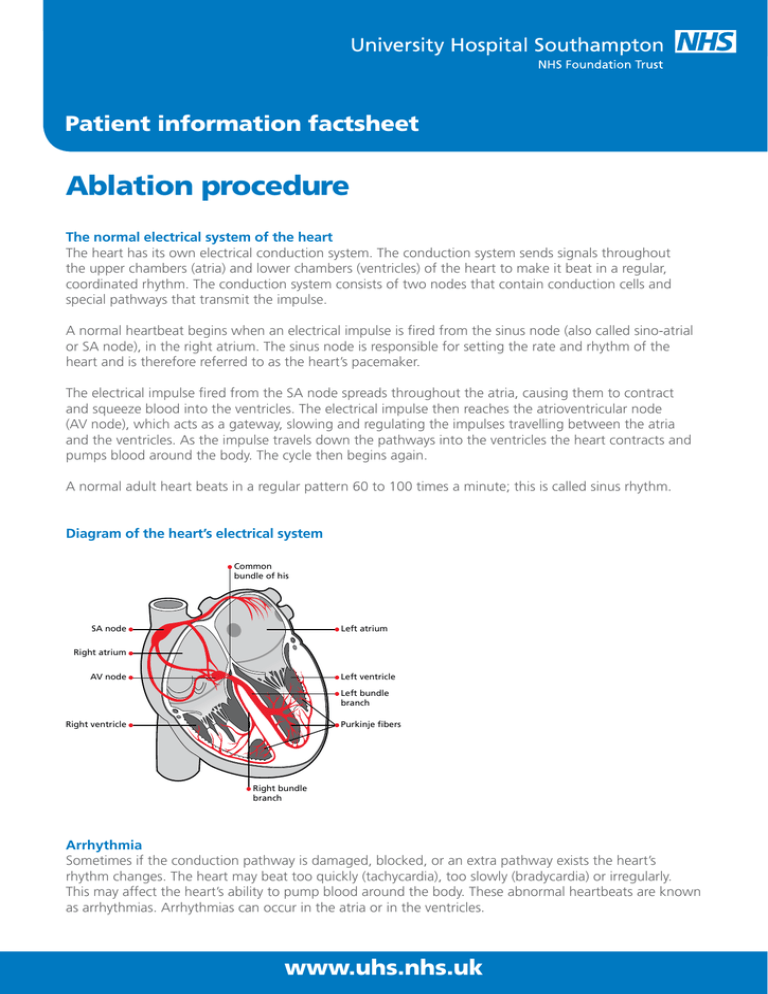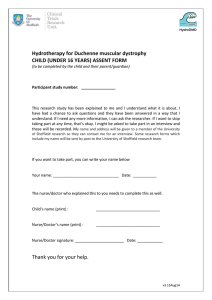
Patient information factsheet
Patient information factsheet
Ablation procedure
The normal electrical system of the heart
The heart has its own electrical conduction system. The conduction system sends signals throughout
the upper chambers (atria) and lower chambers (ventricles) of the heart to make it beat in a regular,
coordinated rhythm. The conduction system consists of two nodes that contain conduction cells and
special pathways that transmit the impulse.
A normal heartbeat begins when an electrical impulse is fired from the sinus node (also called sino-atrial
or SA node), in the right atrium. The sinus node is responsible for setting the rate and rhythm of the
heart and is therefore referred to as the heart’s pacemaker.
The electrical impulse fired from the SA node spreads throughout the atria, causing them to contract
and squeeze blood into the ventricles. The electrical impulse then reaches the atrioventricular node
(AV node), which acts as a gateway, slowing and regulating the impulses travelling between the atria
and the ventricles. As the impulse travels down the pathways into the ventricles the heart contracts and
pumps blood around the body. The cycle then begins again.
A normal adult heart beats in a regular pattern 60 to 100 times a minute; this is called sinus rhythm.
Diagram of the heart’s electrical system
Common
bundle of his
Left atrium
SA node
Right atrium
AV node
Left ventricle
Left bundle
branch
Right ventricle
Purkinje fibers
Right bundle
branch
Arrhythmia
Sometimes if the conduction pathway is damaged, blocked, or an extra pathway exists the heart’s
rhythm changes. The heart may beat too quickly (tachycardia), too slowly (bradycardia) or irregularly.
This may affect the heart’s ability to pump blood around the body. These abnormal heartbeats are known
as arrhythmias. Arrhythmias can occur in the atria or in the ventricles.
www.uhs.nhs.uk
Patient information factsheet
Ablation
An ablation is performed in people who have been diagnosed with an abnormal heart rhythm that has
not responded to medication.
Your arrhythmia is due to an area of extra electrical activity (short circuit) within your heart. In your heart,
the electrical impulses bypass the normal conduction pathway and use an extra electrical pathway or
arise from a group of cells (foci) instead.
The procedure
For your heart to beat normally again, the extra pathway or group of cells (foci) responsible for your
arrhythmia must be blocked. Ablation is a technique where the doctor applies a small about of energy,
the source of which is either radiofrequency (heat) or cryo (cold), via a catheter (thin, flexible wire)
directly onto the area responsible for the extra electrical circuit within your heart. The use of energy
causes scar tissue to form which blocks the area from generating or conducting the fast impulses that
cause your arrhythmia, providing relief from the symptoms you have been experiencing. Therefore, the
normal conduction pathway takes over and your heart rhythm returns to normal. This technique has a
high success rate of curing many different types of arrhythmias. It is performed under a local anaesthetic,
with sedation which will help you to relax.
X-ray screening is used during the procedure so if you think you may be pregnant you should let us
know before the procedure.
Risks of the procedure
Ablation is safe; however as with any procedure there are potential risks. The risks will be fully explained
by our doctors before you have your procedure. Ablation is performed safely in both children and adults.
If you are known to have underlying coronary heart disease the procedural risks are slightly increased.
All the risks outlined below can be treated and are rarely life threatening.
• Blood vessel damage: occasionally the catheter electrodes can accidentally damage the blood vessels
when being moved into position within the heart. The risk of this happening to you is between 3%
and 5%. Serious injury to the blood vessels requiring a surgical procedure to repair the damage is
extremely rare and occurs in less than 1% of patients.
• Pneumothorax: (if the vein under your collarbone is used) very occasionally the catheter electrodes can
puncture the lung wall. Air leaks out of the lungs and collects in the space between the lung and chest
wall, resulting in partial or complete collapse of the lung. If this happens the doctor may need to insert
a drain to reinflate your lungs. The risk of this happening to you is less than 1%.
• Haemothorax: (if the vein under your collarbone is used) very occasionally the catheter electrodes can
puncture the lung wall. Blood leaks out of the lungs into the pleural cavity, the space between the
lungs and the walls of the chest. If this happens the doctor will need to insert a drain to reinflate your
lungs. The risk of this happening to you is less than 1%.
• Pulmonary embolism or stroke: the risk of developing blood clots that travel to the lungs (pulmonary
embolism) or brain (stroke) is extremely rare, less than 1%.
• Palpitations: it is common to experience palpitations (extra heartbeats) during the procedure, due to the
catheter electrodes stimulating your heart. Your heartbeat will usually return to its normal rhythm very
quickly without needing further treatment. However, very occasionally extra treatment (cardioversion) is
www.uhs.nhs.uk
Patient information factsheet
needed to correct your arrhythmia. Cardioversion is a treatment for heart rhythms that are irregular. You
will be given a short-acting sedative to make you sleepy. Once you are asleep a defibrillator is used to
send electrical energy to the heart muscle to restore the normal rhythm and rate.
• Cardiac tamponade: during placement, the catheters may puncture the heart muscle causing blood
to collect around the heart. If this happens the doctor may need to insert a drain to remove it. The
risk of this happening to you is less than 1%; this risk increases slightly if your doctor needs to make a
transeptal puncture (see below).
• Transeptal puncture: during the procedure it is sometimes necessary for your doctor to make a small
hole in the heart (transeptal puncture) in order to gain access to the left side of the heart. This hole will
usually seal up quickly after the procedure. Very occasionally the hole remains open; if this happens
you may need surgery to close it.
• New arrhythmias: very occasionally the ablation catheter can damage your heart’s own conduction
system and new arrhythmias may occur. If the heart’s normal conduction pathway is partly or completely
blocked, a rhythm called heart block may develop which results in failure of the electrical impulses to
travel through the AV node from the atria to the ventricles. If this happens you will need a permanent
pacemaker fitted before you leave hospital to maintain a normal, regular heartbeat. The risk of needing
a permanent pacemaker is less than 1%. However, if you have an extra pathway located close to the AV
node there is an increased risk of between 1 and 2%. A pacemaker is a small battery-operated device
that sends out electrical signals to start a heartbeat when your heart is beating too slowly.
• Bruising and bleeding: this is common in the groin following the procedure. This usually disappears
within a week and does not cause a problem.
• Palpitations (extra heartbeats) after the procedure: you may also experience them on and off for a few
weeks after the procedure, until the small scars created in the heart heal. Sometimes, you may feel as
if your abnormal heart rhythm is returning, but then it suddenly stops. These sensations are normal
and you should not be alarmed. However, if you feel your abnormal heart rhythm has returned, you
should call your GP.
• Success rate: the ablation procedure is not always successful. The success rate depends on where the
problem is within your heart. Your doctor will discuss the success rate of your particular procedure
with you on an individual basis before you sign your consent form. If the procedure is unsuccessful it
may be possible to repeat it at a later date.
Before admission
If you are taking medication to control your heart rhythm the admission coordinator may advise you to
stop taking your tablets five days before your procedure. This is to allow your doctor to make a better
assessment of your heart rhythm. Stopping your tablets may cause your symptoms to return.
If you are taking warfarin (blood thinner) regular blood tests will be needed for at least four weeks
before the procedure, usually at your doctor’s surgery. We ask that you keep your INR between 2.0 and
3.0. A record of this should be kept in your yellow warfarin book. We also request that you check your
INR three days before your admission (please contact the admissions office on the number given on the
last page of this information sheet) to confirm it is in range to enable the procedure to go ahead.
If you are taking an alternative anticoagulant then you will be given an individual management plan
to follow.
The above advice should be followed unless your admissions letter advises otherwise.
www.uhs.nhs.uk
Patient information factsheet
If you have any questions please talk to the admission coordinator about the medicines that you are
currently taking.
Before the procedure
On your arrival to the ward a nurse will talk to you and your family about your hospital admission and
answer any questions you may have. Before the procedure, you will have blood tests taken and an
electrocardiogram (ECG) recorded. A doctor will also see you to explain the procedure to you, and ask
you to sign a consent form to ensure you understand the procedure and the associated risks. If you have
any worries or questions please do not be afraid to ask. It is important to tell your nurse or doctor if you
have any allergies or have had a previous reaction to drugs or other tests. If you are having the procedure
done under a general anaesthetic, you will also talk to an anaesthetist.
A doctor or nurse will need to insert a small needle into a vein in your hand (cannula) in order to give
you drugs during the procedure. You will also be asked to shave your groin and if necessary your upper
chest and you will then be given a hospital gown to wear.
You will be advised not to eat for six hours before your procedure. If you are diabetic, your nurse will
discuss your tablets/insulin dose with you, because not eating may affect your blood sugar levels.
The procedure could take a couple of hours. You may wish to let your family know so that they do not worry.
During the procedure
You will be taken to the catheter lab where a nurse will stay with you and be there to reassure you
throughout the procedure. There is a lot of equipment in the room, which is used to monitor your heart
rhythm. You will be awake during the procedure, but to help you relax your doctor will give you a short
acting sedative.
The doctor will inject a local anaesthetic into your groin to numb your leg. This may sting a little and
you may feel some mild discomfort. When the local anaesthetic has taken effect, the doctor will insert
a small tube (sheath) into your groin. You should not feel any pain, but let your doctor know if you do.
Through the sheath the doctor will gently thread several flexible wires (catheter electrodes) into
your heart. These special wires will record and ablate (destroy) the extra electrical signals from within
your heart. The type of arrhythmia you have will determine how many wires your doctor will use for
your ablation. The catheters are about the size of a small drinking straw. The doctor carefully moves the
catheters into different positions within your heart under x-ray screening (sometimes, your doctor may
also put a catheter into one of your veins below your collarbone). You should not feel pain during this
part of the procedure.
Once the catheters are in place, your doctor will attempt to start your arrhythmia by giving your heart
small electrical impulses (paced beats) to make it beat at different speeds. This allows the doctor to
collect detailed information about the cause of your arrhythmia and pinpoint where the area of extra
electrical activity responsible for your arrhythmia is within your heart. During this time you may feel your
heart speeding up, slowing down or missing a beat. This may cause you some mild discomfort.
However, this is a normal part of the procedure and in the controlled setting of an ablation is not a
danger to you. Sometimes, your doctor may also need to give you drugs to bring on your arrhythmia.
The doctor will use the ablation catheter to deliver a small amount of energy (either heat or cold) directly
onto the area of extra electrical activity to create a scar.
You may feel a slight burning sensation or heaviness in your chest during this part of the procedure.
The formation of scar tissue as a result of ablation will not interfere with the normal conduction or function
of the heart. This means that after ablation your heartbeat will only follow the normal electrical pathway.
www.uhs.nhs.uk
Patient information factsheet
If you experience any symptoms during the procedure, for example, chest pain, dizziness or shortness of
breath please tell your nurse or doctor.
After the doctor has performed the ablation, you will be kept in the catheter lab and continue to be
monitored for approximately 20 minutes. The doctor will then stimulate your heart again in an attempt
to start your arrhythmia. If this is not possible the ablation is considered a success.
After the procedure is completed the catheter and IV line will be removed. Firm pressure will be applied
to your groin where the catheter was inserted to stop you from bleeding.
After the procedure
After the procedure you will be moved to the recovery area where you will be monitored for a short
time. On returning to the ward you will need to rest for a few hours. You may feel a little sleepy until
your sedative has worn off. The nurse will record an ECG, check your blood pressure, pulse and feel
your foot pulses. The nurse will also check your groin for any bleeding. It is important that you remain
in bed and avoid bending your affected leg for approximately two hours after the catheters have been
removed. This is to prevent any bleeding from the puncture site. After this time you will be able to get
up if there are no complications. You will be able to eat and drink normally as soon as you return to the
ward. The nurse will remove the small needle in your hand. If you feel any palpitations or dizziness after
the test, please let the nurse know. You may also have a chest x-ray to make sure that you do not have a
pneumothorax (pocket of air) in your lung.
Results
Your doctor will usually discuss the results and ongoing treatment plan with you and your family after
the procedure.
Going home
You will normally be able to go home the following day. It is important to ask a family member or friend
to collect you and drive you home. If you are being discharged home the same day as your procedure we
would advise you to have someone stay with you for the night. Before going home, your doctor or CRM
nurse will advise you regarding the medicines you will need to take, or stop and your follow-up care.
Caring for your wound
You will have a small dressing on your puncture site that can be removed the next day. It is important to
keep the area clean and dry until it has healed. If you notice any swelling, redness or oozing please let
your GP know.
Resuming normal activities
You can resume your normal daily activities when you leave hospital. You should not strain or lift heavy
objects for a few days so the incision site can heal. Unless your job requires you to lift heavy objects,
you can return to work in a day or two. You are advised not to drive a car for one week. If you hold a
Group 2 PSV licence (lorries/buses) you are not allowed to drive for six weeks.
www.uhs.nhs.uk
Patient information factsheet
Follow-up care
Our cardiac rhythm management team will give you specific follow-up instructions when you leave
hospital. Our doctors will write a detailed letter to your GP describing your hospital stay and treatment.
Cancellations
Unfortunately we do sometimes have to cancel procedures. If this happens to you, we will always try to
explain the reason. We fully appreciate that this is a stressful time for you and your family and we will do
our best to provide you with a new date that is convenient for you as soon as possible.
Further information and contacts
We cannot guarantee that a particular person will perform the procedure. The person will, however,
have appropriate experience.
If you have any questions regarding your forthcoming procedure please call 023 8120 8436 to speak to
a cardiac rhythm management clinical nurse specialist. If you have a query relating your admission date
please contact the cardiac rhythm management coordinator on 023 8120 8772.
You can also email crmnurses@uhs.nhs.uk
The following websites also provide useful information:
www.bhf.org.uk
www.heartrhythmcharity.org.uk
If you need a translation of this document, an interpreter
or a version in large print, Braille or on audio tape, please
telephone 023 8120 4688 for help.
© 2015 University Hospital Southampton NHS Foundation Trust. All rights reserved. Not to be reproduced in whole or in part without the permission of the copyright holder.
Version 4. Published April 2015. Due for review April 2018 2014-726 (4)
www.uhs.nhs.uk






